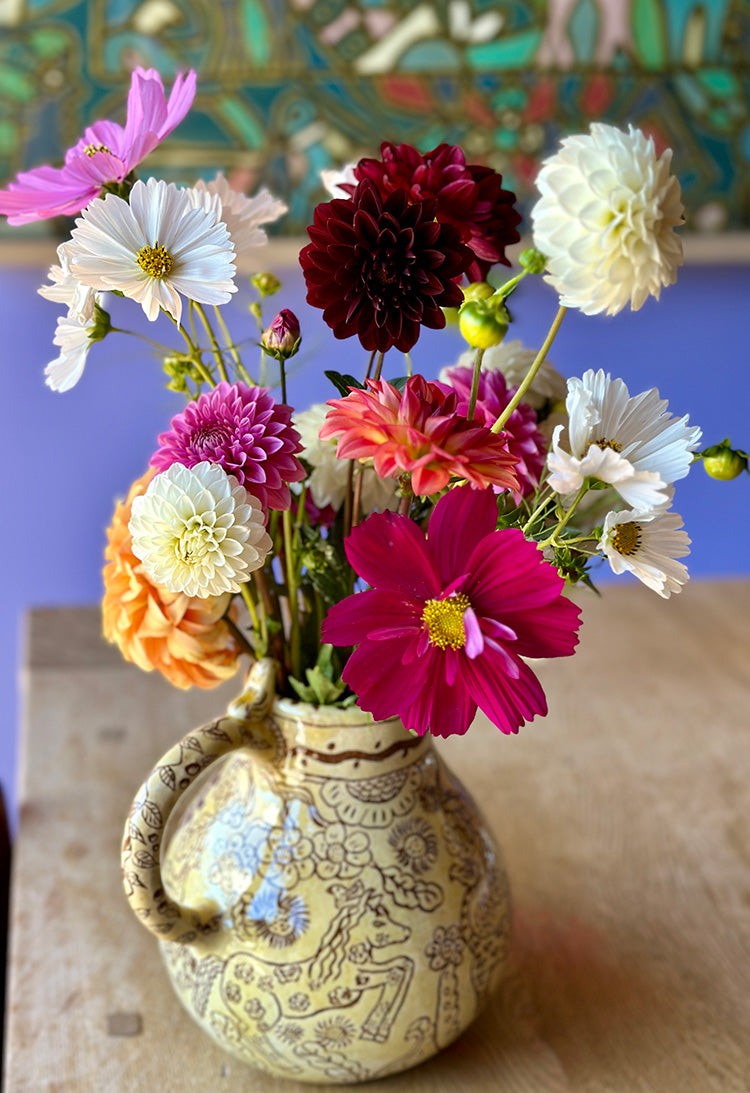All of us have to learn how to invent our lives, make them up, imagine them. We need to be taught these skills; we need guides to show us how. Without them, our lives get made up for us by other people.
-Ursula K. Le Guin
They say if you don’t like the weather in the Rockies, wait five minutes. And right on cue, our first big winter storm and single-digit temperatures arrived in time for Halloween. Every year, I look forward to the cozy season, to snow sports, to my family coming together, to more focused time in the studio, more writing and reading, and comfort food dinners by the fire — all of the winter delights that the Danish famously dubbed as hygge. And I am mindful that in these fraught days, the ability to withdraw into a more cocooned existence is the ultimate luxury. Our high alpine winters are long, so I designed a home that beats back the melancholy that comes with less daylight. When the temperatures dip, we entertain as much as possible to keep another kind of warmth flowing.
All of this didn’t come from thin air. My mother, Jessica, had a great design eye and was a celebrated hostess. As a diplomat’s wife, she was expected to entertain and be a dutiful public servant. She worked a full-time job alongside my father, all without compensation, of course, But she elevated this obligation to an art form. She knew how to curate intriguing people from different backgrounds, took particular care with her seating arrangements, and ensured conversation was invigorating but civil. She set a gorgeous table and eschewed formality in favor of texture, like mismatched colored glasses set off by textiles from a flea market in Mexico or a souk in Morocco instead of formal tablecloths and threw in different china patterns for good measure. She arranged flowers in unusual containers from her celebrated garden and kept the lighting low and the candles lit. She created the kind of table where guests lingered, much to my father Henry’s chagrin since he rose each morning at 5 a.m. 
My mother had rules about hospitality. Greet people at the door if possible. Make everyone welcome, introduce newcomers to other guests, and ensure everyone feels included in the conversation. Serve comfort food and excellent wine. And when the tables turned, and you were the guest–bring a hostess gift, be gracious and curious, and leave bad moods and poor manners at the door. She also taught me the importance of reciprocity. If someone has you over, return the favor. Sometimes, you cannot reciprocate in kind, but you can return the hospitality in another way – a walk, a cup of tea, or a check-in with a note or email and, above all, say thank you. My mom hated formal stationery, so she always scrawled her thanks on funky postcards she collected over the years. She knew keeping hospitality flowing back and forth was essential to nudging yourself out of your comfort zone and keeping open to new people and perspectives.
Jessica knew her beautiful table played a supporting role–her house was always the star of the show. Her interiors pulled you in with color and comfort, inviting you to settle in. Books were everywhere–her favorites were stacked like hotcakes on various surfaces but never organized. Dogs and children drifted around, often nesting together on a favorite sofa. Found treasures from travels and walks were scattered on the coffee table – a wild turkey feather, a beaded Masai necklace, or a gleaming hollow chestnut or an unusual stone. She showcased high and low side by side – a valuable painting would hang with equal weight next to a drawing from one of her grandkids. She used an heirloom Meissen gravy charger for keys. She loathed houses that were formal, pretentious, and without a pulse. For her, a house was a sentient being. A house should not only be welcoming but also offer insight to those who dwelt within. She never employed an interior designer because her domestic space was her canvas and no one else’s.
I followed suit. The word sanctuary stems from the Latin sanctuarium– a place for holy relics or spaces. Later, the definition evolved into its more modern meaning, a space for beloved people and animals. Twenty years ago, I designed a house and surrounding gardens that gave respite from the outside world for our small kids and us – a place that was colorful, playful, quirky, and welcoming—a home filled with work from artist friends who are integral parts of our lives. I installed bookcases in every room, covered furniture with fabrics sourced from eBay, and oversaw every detail, like balcony designs and custom light fixtures. During the growing season, I fill rooms with flowers from my cutting garden and fling the doors open during the day. Our house is home base, like that tree in a capture-the-flag game where you were always safe, a place for my beloveds to return to when the world is challenging. Above all, our house celebrates the ones I love, both the living and those who remain as memories.





1 comment
Beautiful, Isa. In a few elegant paragraphs, you managed to verbally embody the idea behind, and the execution of, your sui generis sanctuary. Your mom would be proud of you— you were clearly paying attention during those state department dinners (I was dressed in kiddie black tie and serving caviar to the resplendent grownups, but even a kid could tell that Mom had created something magical, larger-than-life with her unique alchemy of curating delicious food, music, and people). Every gathering of yours fills me with remembered joy and nostalgia. Congratulations on artfully continuing the high art of sanctuary for your grateful acolytes! As you noted, these theatrical gatherings of grace are needed now more than ever as we navigate the grim and murky waters outside.